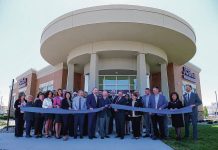Students in Miyoshi, Japan, have few freedoms when it comes to education.
Until the time they can go to college, Miyoshi students are not allowed to choose what courses they take, but instead are assigned to the classes education leaders deem most appropriate.
Similarly, students in Miyoshi are expected to wear uniforms to school, with students donning outfits that are identical to the outfits their peers of the same gender are wearing.
That sort of prescriptive environment made coming to Columbus as part of a sister city exchange a bit of a culture shock for the group of eighth-grade students from Miyoshi visiting Columbus this week.
[sc:text-divider text-divider-title=”Story continues below gallery” ]
“School is different — it’s more free (in Columbus),” 14-year-old Natsuya Yoshimi said through a translator.
Natsuya and his fellow eighth-graders have spent the past week in Columbus, living with host families and learning about the differences between the American and Japanese education systems as part of a two-decade-long sister city educational exchange program.
Miyoshi and Columbus became sister cities in 1994, and the first educational delegation from Columbus visited Miyoshi in 1996. Since that time, students and teachers from both cities have been traveling to visit each other to learn more about educational practices on the other side of the world.
The Miyoshi eighth graders, who arrived in Columbus on Friday, spent Monday and Wednesday as they would spend any other day in Japan — attending classes at school.
The Japanese students visited either Northside or Central middle schools, where Natsuya said the educational freedoms American students have — such as the ability to customize their class schedules or choose their own clothes — came as quite a shock to him.
Cinde Wirth, a teacher at Columbus Signature Academy _ New Tech campus and last year’s Bartholomew Consolidated School Corp. ambassador to Miyoshi, said she was also struck by the difference in educational philosophies across the world when she visited Miyoshi last October.
BCSC follows the teachings of Universal Design for Learning, an educational practice that advocates for teaching to students’ individual needs. That philosophy is much different than the standardized education students in Miyoshi receive, Wirth said.
While the CSA _ New Tech teacher said she does not think there is anything wrong with the Japanese educational philosophy, she also said her trip to Miyoshi made the benefits of UDL and individualized learning much more obvious.
“When you stand back and look at the differences, you see the value in those differences,” Wirth said.
But while educators in Columbus and Miyoshi take different approaches to teaching, Wirth said one common denominator was obvious — the teachers in Miyoshi want their students to succeed just as much as teachers in Columbus want local students to succeed.
And as far as the students are concerned, Wirth said she noticed few differences between the behaviors of young teens in Columbus or in Miyoshi.
That fact was proven true on Tuesday, when the Miyoshi youngsters took a tour of downtown Columbus.
They posed for pictures with their friends, snapped shots of their favorite architectural gems — usually using digital cameras, not smart phones like many American students would use — and even tried to photobomb each other’s pictures, all behaviors that are typical of American teenagers.
Natsuya and his classmate, Haruna Mitsuoka, said their favorite stop of the day was the kidscommons children’s museum, where the group got a huge laugh out of going down the giant toilet.
As she toured the city, Haruna said she noticed some similarities between Miyoshi and Columbus that made her feel at home, namely the lush green landscape.
As the Japanese students prepare to fly back home Friday, Wirth said she feels lucky that she and other Columbus teachers and students have had the opportunity to enhance their own educational experiences by exposing themselves to the cultures and educational practices of a sister city community across the globe.
“We’re very fortunate to have this partnership so well supported by BCSC,” Wirth said.
[sc:pullout-title pullout-title=”History of sister city relationship” ][sc:pullout-text-begin]
Columbus, Indiana and Miyoshi City, Japan became sister cities on July 5, 1994, when mayors Bob Stewart and Michio Tsukamoto signed a cultural partnership agreement. The relationship was formalized on Nov. 30, 1994.
Similar sizes and industries brought the two cities together. Since the partnership was formed, business, education and even women’s groups have traveled between the two cities to foster relationships.
Today in Columbus, evidence of the partnership is seen along the Friendship Alley, where cherry trees from Miyoshi City bloom.
[sc:pullout-text-end]




